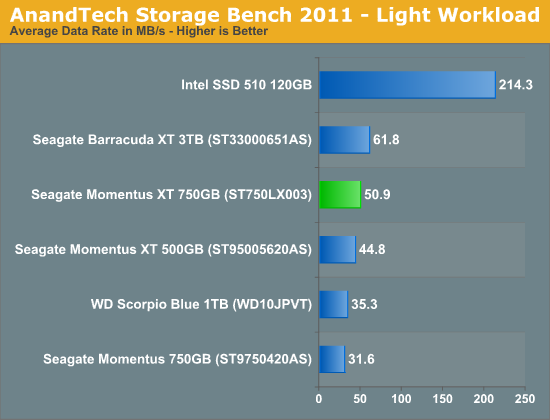Seagate 2nd Generation Momentus XT (750GB) Hybrid HDD Review
by Anand Lal Shimpi on December 13, 2011 12:51 AM EST- Posted in
- Storage
- Seagate
- Momentus XT
- Hybrid Drive
- HDDs
- SSHDs
AnandTech Storage Bench 2011
Admittedly most of the benchmarks on the previous page really portray the Momentus XT in the best light possible. The workloads are light enough to mate well with the 8GB cache and none of them are really write intensive. Over time however you'll encounter more varied workloads, including those that are write intensive or those that only access data once or twice. In workloads that aren't perfectly tailored to the Momentus XT's cache, the honeymoon is over before it began. We'll start with our light storage bench:

Here overall performance is definitely higher than any of the 2.5" drive offerings, including last year's 500GB Momentus XT. However compared to the 3.5" Barracuda XT, the newer Momentus XT is tangibly slower over the course of our test. If you look at performance compared to the Intel SSD 510, there's simply no competition.
Our trace based Storage Bench suites were designed to really stress SSDs, thus being more write intensive than your typical client workload. Not being able to cache writes at this point, the Momentus XT is penalized (perhaps unfairly) in these benchmarks. The results are valid however - when it comes to writing or non-repetitive workloads, the Momentus XT will perform like a good 2.5" hard drive rather than in the realm of SSD performance.
Our Heavy Storage Bench workload is even more write intensive. Furthermore, having been recorded on a Windows 7 pre-SP1 install, we see some of the potential penalties from moving to a 4KB sector drive. Most writes are 4KB aligned in Windows 7, however pre-SP1 there were still some significant cases where alignment could be an issue. Here we see the 750GB/4KB Momentus XT actually fall behind the 500GB drive with 512B sectors because of this difference:

I included these results because if you formatted your drive with Windows 7 and later applied SP1 to the install, you may see this sort of performance regression when moving to a 4KB sector drive. The only way to avoid this is to reformat your drive using Windows 7 SP1 and install from a Windows 7 SP1 DVD/image. In place upgrades won't avoid the alignment issues that are exhibited here. For a greater understanding of why 4KB sectors are necessary and why alignment can be problematic on these drives, have a look at our coverage here.










98 Comments
View All Comments
kyuu - Thursday, December 15, 2011 - link
Yes, I saw this directly stated by a Seagate rep somewhere. I'm much too lazy at the moment to go hunting for it or another confirmation.Rest assured, if the SLC fails before the platter portion for some reason, the drive will work just fine as a regular drive minus the NAND caching.
Blaze-Senpai - Wednesday, December 14, 2011 - link
I'd be more worried about the platter-portion of the drive failing first, to be honest.axisofevil35 - Tuesday, December 13, 2011 - link
Ok so it's 750GB 7200RPM Momentus XT.... when can we BUY a 1TB 7200RPM Momentus XT model?kyuu - Thursday, December 15, 2011 - link
Whenever they release the next model. Hopefully they will come out with new XT models on a more regular basis (there was a pretty long hiatus between the previous XT and this one), but who knows.We'll likely see a 1GB+ Barracuda XT hybrid before then, though.
Arbie - Tuesday, December 13, 2011 - link
I strongly considered a Momentus when they came out, probably based on Anandtech's remarks, but user reports on various forums killed that idea. Sorry to spread FUD, which it is at this point since I don't have any links, but at the time there was no end of bad news. If you're considering one of these, find out what you can on reliability first.
golob - Tuesday, December 13, 2011 - link
I'd be really curious how the Momentus XT drives compare to a z68-based SSD-cache--just to get a sense of the performance of the caching algorithms from Seagate and Intel respectively.Toughbook - Tuesday, December 13, 2011 - link
I picked up the 1st gen while trying to decide on a SSD to buy. At the time I had a main stream Hitachi 320GB running in my laptop. I could not notice a difference at all between the two. It was very loud and produced more heat as well. Obviously users of this drive are looking for more performance than a regular HDD. If one were to shop around and spend roughly $100.00 more you can get a Samsung 470 256GB. It will blow this drive away of course, plus the reliability is ten fold. Seagate better watch there pricing as SSD's are going down in cost almost weekly.adamantinepiggy - Tuesday, December 13, 2011 - link
Since a striped array is spreading out the read/swrites, the data from/to each drive is smaller and probably fit in the small NAND cache better. Just guessing..Revdarian - Tuesday, December 13, 2011 - link
Just wanted to cheer Anandtech as this is still the best site for real storage reviews.You guys have no problem in finding the proper target for your reviews, be it professional or casual use and all inbetween, and after doing so you produce a proper review for the specific target.
CHEERS!
Proph3T08 - Tuesday, December 13, 2011 - link
When you recommend desktop users get a SSD and an HDD are you recommending that people set up the SSD for caching the HDD or leave the two drive completely separate?If we are to set up SSD caching which SSD size would be best for that?